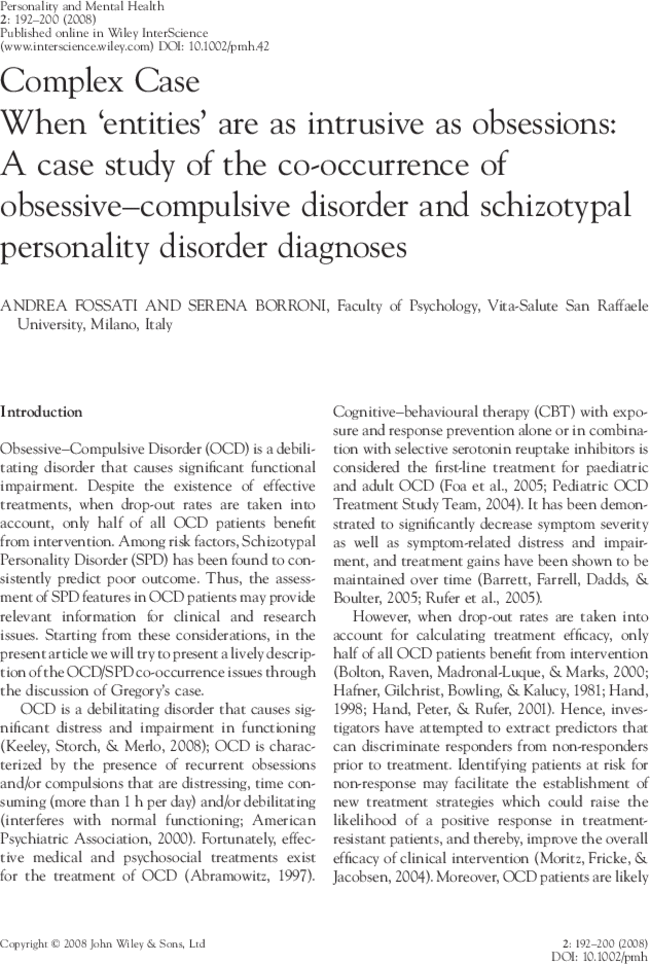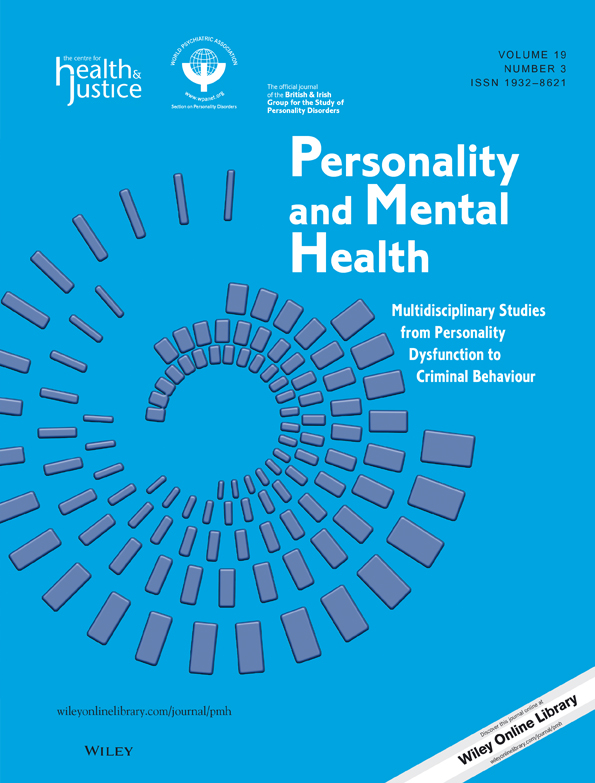Complex Case
When ‘entities’ are as intrusive as obsessions: A case study of the co-occurrence of obsessive–compulsive disorder and schizotypal personality disorder diagnoses
Andrea Fossati,
Serena Borroni,
Corresponding Author
Andrea Fossati
Faculty of Psychology, Vita-Salute San Raffaele University, Milano, Italy
Servizio di Psicologia Clinica e Psicoterapia, San Raffaele Turro, via Stamira d'Ancona, 20, 20127 Milano, ItalySearch for more papers by this authorSerena Borroni
Faculty of Psychology, Vita-Salute San Raffaele University, Milano, Italy
Search for more papers by this authorAndrea Fossati,
Serena Borroni,
Corresponding Author
Andrea Fossati
Faculty of Psychology, Vita-Salute San Raffaele University, Milano, Italy
Servizio di Psicologia Clinica e Psicoterapia, San Raffaele Turro, via Stamira d'Ancona, 20, 20127 Milano, ItalySearch for more papers by this authorSerena Borroni
Faculty of Psychology, Vita-Salute San Raffaele University, Milano, Italy
Search for more papers by this author
REFERENCES
- Abramowitz, J. S. (1997). Effectiveness of psychological and pharmacological treatments for obsessive–compulsive disorder: a quantitative review. Journal of Consulting and Clinical Psychology, 65, 44–52.
- Albert, U., Picco, C., Maina, G., Corner, F., Aguglia, E., & Bogetto, F. (2002). Fenomenologia del paziente con disturbo ossessivo-compulsivo ad esordio precoce e ad esordio in età adulta [Phenomenology of patients with early- and adult-onset obsessive–compulsive disorder]. Epidemiologia e Psichiatria Sociale, 11, 116–126.
- American Psychiatric Association. (2000). Diagnostic and statistical manual of mental disorders ( 4th ed.) (text revision). Washington, DC: American Psychiatric Association.
- Baer, L., Jenike, M. A., Black, D. W., Treece, C., Rosenfeld, R., & Greist, J. (1992). Effect of axis II diagnoses on treatment outcome with clomipramine in 55 patients with obsessive–compulsive disorder. Archives of General Psychiatry, 49, 862–866.
- Barrett, P., Farrell, L., Dadds, M., & Boulter, N. (2005). Cognitive-behavioral family treatment of childhood obsessive–compulsive disorder: Long-term follow-up and predictors of outcome. Journal of the American Academy of Child and Adolescent Psychiatry, 44, 1005–1014.
- Black, D. W., & Noyes, R. (1997). Obsessive–compulsive disorder and axis-II. International Review of Psychiatry, 9, 111–118.
- Bolton, D., Raven, P., Madronal-Luque, R., & Marks, I. M. (2000). Neurological and neuropsychological signs in obsessive–compulsive disorder: Interaction with behavioural treatment. Behaviour Research and Therapy, 38, 695–708.
- Bottas, A., Cooke, R. G., & Richter, M. A. (2005). Comorbidity and pathophysiology of obsessive–compulsive disorder in schizophrenia: Is there evidence for a schizo-obsessive subtype of schizophrenia? Journal of Psychiatry & Neuroscience, 30, 187–193.
- Dinn, W. M., Harris, C. L., Aycicegi, A., Greene, P., & Andover, M. S. (2002). Positive and negative schizotypy in a student sample: Neurocognitive and clinical correlates. Schizophrenia Research, 56, 171–185.
- Eisen, J. L., & Rasmussen, S. A. (1993). Obsessive–compulsive disorder with psychotic features. Journal of Clinical Psychiatry, 54, 373–379.
- Foa, E. B., Liebowitz, M. R., Kozak, M. J., Davies, S., Campeas, R., & Franklin, M. E., et al (2005). Randomized, placebo-controlled trial of exposure and ritual prevention, clomipramine, and their combination in the treatment of obsessive–compulsive disorder. American Journal of Psychiatry, 162, 151–161.
- Hafner, R. J., Gilchrist, P., Bowling, J., & Kalucy, R. (1981). The treatment of obsessional neurosis in a family setting. Australian and New Zealand Journal of Psychiatry, 15, 145–151.
- Hand, I. (1998). Out-patient, multi-modal behaviour therapy for obsessive–compulsive disorder. British Journal of Psychiatry, 173, 45–52.
- Hand, I., Peter, H., & Rufer, M. (2001). Kombinationsbehandlung mit verhaltenstherapie und pharmakotherapie bei zwangsstörungen: Forschungsstand und behandlungspraxis [Combined behavioral and pharmacological treatment for obsessive–compulsive disorders: Research findings and clinical practice]. Verhaltenstherapie, 11, 206–215.
- Harris, C. L., & Dinn, W. M. (2003). Subtyping obsessive–compulsive disorder: Neuropsychological correlates. Behavioural Neurology, 14, 75–87.
- Keeley, M. L., Storch, E. A., & Merlo, L. J. (2008). Clinical predictors of response to cognitive-behavioral therapy for obsessive–compulsive disorder. Clinical Psychology Review, 28, 118–130.
- Matsunaga, H., Kiriike, N., Matsui, T., Miyata, A., Iwasaki, Y., Fujimoto, K., Kasai, S., & Kojima, M. (2000). Gender differences in social and interpersonal features and personality disorders among Japanese patients with obsessive–compulsive disorder. Comprehensive Psychiatry, 41, 266–272.
- Mitropoulou, V., Harvey, P. D., Maldari, L. A., Moriarty, P. J., New, A. S., Silverman, J. M., & Siever, L. J. (2002). Neuropsychological performance in schizotypal personality disorder: Evidence regarding diagnostic specificity. Biological Psychiatry, 52, 1175–1182. DOI: 10.1016/S0006-3223(02)01426–9.
- Moritz, S., Fricke, S., & Jacobsen, D. (2004). Positive schizotypal symptoms predict treatment outcome in obsessive–compulsive disorder. Behaviour Research and Therapy, 42, 217–227.
- Norman, R. M., Davies, F., Malla, A. K., Cortese, L., & Nicholson, I. R. (1996). Relationship of obsessive–compulsive symptomatology to anxiety, depression and schizotypy in a clinical population. British Journal of Clinical Psychology, 35, 553–566.
- Poyurovsky, M., & Koran, L. M. (2005). Obsessive–compulsive disorder (OCD) with schizotypy vs. schizophrenia with OCD: Diagnostic dilemmas and therapeutic implications. Journal of Psychiatric Research, 39, 399–408.
- Rossi, A., & Daneluzzo, E. (2002). Schizotypal dimensions in normals and schizophrenic patients: A comparison with other clinical samples. Schizophrenia Research, Special issue: NATO advanced research workshop on schizophrenia and schizotypy, 54, 67–75.
- Roth, R. M., & Baribeau, J. (2000). The relationship between schizotypal and obsessive–compulsive features in university students. Personality and Individual Differences, 29, 1083–1093.
- Rufer, M., Hand, I., Alsleben, H., Braatz, A., Ortmann, J., & Katenkamp, B., et al (2005). Long-term course and outcome of obsessive–compulsive patients after cognitive-behavioral therapy in combination with either fluvoxamine or placebo: A 7-year follow-up of a randomized double-blind trial. European Archives of Psychiatry and Clinical Neuroscience, 255, 121–128. DOI 10.1007/s00406-004-0544-8.
- Sobin, C., Blundell, M. L., Weiller, F., Gavigan, C., Haiman, C., & Karayiorgou, M. (2000). Evidence of schizotypy subtype in OCD. Journal of Psychiatric Research, 34, 15–24.
- Storch, E. A., & Merlo, L. J. (2006). Obsessive–compulsive disorder: Strategies for using CBT and pharmacotherapy. The Journal of Family Practice, 55, 329–333.
- Pediatric OCD Treatment Study (POTS) Team. (2004). Cognitive-behavior therapy, sertraline, and their combination for children and adolescents with obsessive–compulsive disorder. Journal of the American Medical Association, 292, 1969–1976.




